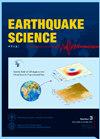The dilatancy-diffusion hypothesis, earthquake prediction, and operational earthquake forecasting: In memory of Professor Amos Nur on the 50th Anniversary of the 1975 Haicheng Earthquake
IF 4.1
4区 地球科学
Q3 Earth and Planetary Sciences
引用次数: 0
Abstract
Dilatancy is referred to the phenomenon of volume increase that occurs when a material is deformed. Dilatancy theory originated in geomechanics for the study of the behavior of granular materials. Later it is expanded to the case of more brittle materials like rocks when it is subjected to the load of varying effective stress and starts to crack and deform, then named the dilatancy-diffusion hypothesis. This hypothesis was developed to explain the changes in rock volume and pore pressure that occur prior to and during fault slip, which can influence earthquake dynamics. Dilatancy-fluid diffusion is a significant concept in understanding the seismogenic process and has served as the major theoretical pillar for earthquake prediction by its classic definition. This paper starts with the recount of fundamental laboratory experiments on granular materials and rocks, then conducts review and examination of the history for using the dilatancy-diffusion hypothesis to interpret the ‘prediction’ of the 1975 Haicheng Earthquake and other events. The Haicheng Earthquake is the first significant event to be interpreted with the dilatancy-diffusion hypothesis in the world. As one pivotal figure in the development of the dilatancy-diffusion hypothesis for earthquake prediction Professor Amos Nur of Stanford University worked tirelessly to attract societal attention to this important scientific and humanistic issue. As a deterministic physical model the dilatancy-diffusion hypothesis intrinsically bears the deficit to interpret the stochastic seismogenic process. With the emergence of deep learning and its successful applications to many science and technology fields, we may see a possibility to overcome the shortcoming of the current state of the theory with the addition of empirical statistics to push the operational earthquake forecasting approach with the addition of the physically-informed neural networks which adopt the dilatancy-diffusion hypothesis as one of its embedded physical relations, to uplift the seismic risk reduction to a new level for saving lives and reducing the losses.
膨胀扩散假说、地震预报与业务地震预报——纪念努尔教授1975年海城地震50周年
膨胀是指材料变形时体积增加的现象。剪胀理论起源于地质力学,用于研究颗粒状材料的行为。后来将其推广到岩石等脆性较强的材料,当其受到变化有效应力的载荷时,开始出现裂纹和变形,称为扩容-扩散假说。这一假设是为了解释断层滑动之前和期间岩石体积和孔隙压力的变化,这些变化会影响地震动力学。膨胀-流体扩散是理解孕震过程的一个重要概念,其经典定义已成为地震预测的主要理论支柱。本文首先叙述了颗粒材料和岩石的基本实验室实验,然后对用膨胀扩散假说解释1975年海城地震和其他事件的“预测”的历史进行了回顾和考察。海城地震是世界上第一个用膨胀扩散假说解释地震的重大事件。斯坦福大学的Amos Nur教授作为地震预测的膨胀扩散假说发展的关键人物,为引起社会对这一重要的科学和人文问题的关注而不懈努力。作为一种确定性的物理模型,膨胀扩散假说在解释随机发震过程中存在固有的缺陷。随着深度学习的出现及其在许多科学和技术领域的成功应用,我们可能会看到通过增加经验统计来克服理论现状的缺点的可能性,通过增加采用膨胀-扩散假设作为其嵌入式物理关系之一的物理信息神经网络来推动操作地震预报方法。将降低地震风险提升到一个新的水平,以挽救生命和减少损失。
本文章由计算机程序翻译,如有差异,请以英文原文为准。
求助全文
约1分钟内获得全文
求助全文
来源期刊

Earthquake Science
GEOCHEMISTRY & GEOPHYSICS-
CiteScore
1.10
自引率
8.30%
发文量
42
审稿时长
3 months
期刊介绍:
Earthquake Science (EQS) aims to publish high-quality, original, peer-reviewed articles on earthquake-related research subjects. It is an English international journal sponsored by the Seismological Society of China and the Institute of Geophysics, China Earthquake Administration.
The topics include, but not limited to, the following
● Seismic sources of all kinds.
● Earth structure at all scales.
● Seismotectonics.
● New methods and theoretical seismology.
● Strong ground motion.
● Seismic phenomena of all kinds.
● Seismic hazards, earthquake forecasting and prediction.
● Seismic instrumentation.
● Significant recent or past seismic events.
● Documentation of recent seismic events or important observations.
● Descriptions of field deployments, new methods, and available software tools.
The types of manuscripts include the following. There is no length requirement, except for the Short Notes.
【Articles】 Original contributions that have not been published elsewhere.
【Short Notes】 Short papers of recent events or topics that warrant rapid peer reviews and publications. Limited to 4 publication pages.
【Rapid Communications】 Significant contributions that warrant rapid peer reviews and publications.
【Review Articles】Review articles are by invitation only. Please contact the editorial office and editors for possible proposals.
【Toolboxes】 Descriptions of novel numerical methods and associated computer codes.
【Data Products】 Documentation of datasets of various kinds that are interested to the community and available for open access (field data, processed data, synthetic data, or models).
【Opinions】Views on important topics and future directions in earthquake science.
【Comments and Replies】Commentaries on a recently published EQS paper is welcome. The authors of the paper commented will be invited to reply. Both the Comment and the Reply are subject to peer review.
 求助内容:
求助内容: 应助结果提醒方式:
应助结果提醒方式:


